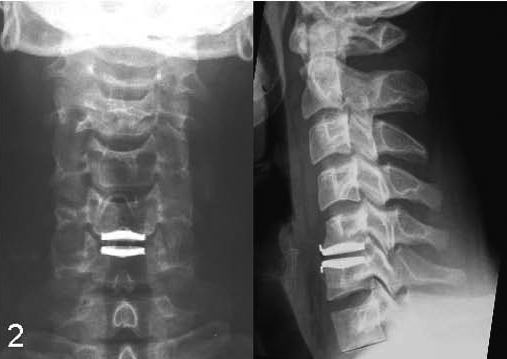Last Updated on October 29, 2023
Artificial cervical disc replacement is a procedure where an artificial device inserted between two vertebrae in the neck to replace a damaged disc.
The natural disc allows load compression and allows motion between the bones in the neck.
Conventional surgeries aim at fusing the adjoining vertebrae as a surgical measure for cervical disc disease. The procedure is anterior cervical discectomy and it addresses the pathology by eliminating motion at the diseased disc level.

Replacing the disc with artificial disc aims at duplicating the natural disc’s form and function.
But doing that is quite challenging with a synthetic or artificial disc. There are several different types of artificial cervical discs which have been developed and are available as a surgical option.
The artificial disc replacement offers the benefit of restoration of disc height, decompression of neural structures an effect and preserve motion at the disc space.
The first report of a cervical disc replacement was reported in 1964.
Indication for Total Disc Arthroplasty or Cervical Artificial Disc Replacement
Artificial disc replacement surgery—also known as a total disc arthroplasty or total disc replacement (TDR) is typically indicated in
- cervical disc herniation that is causing significant neck pain and/or arm pain
- No response to nonsurgical treatment [4-6 weeks trial]
- Quality of life and ability to function is affected
The symptoms of the patient could be due to a herniated disc per se and/or osteophytes (bone spurs) compressing adjacent nerves or the spinal cord.
Most commonly the cervical disc disease occurs at cervical spine levels C4-C5, C5-C6, or C6-C7.
In addition, the following criteria is desirable
- No prior neck surgery (typically)
- Suitable general health for safe anesthesia
- Only one, or possibly two, levels of the neck affected
- No facet joint arthritis
- No active infection
- Absence of Osteoporosis
Advantages of the Artificial Cervical Disc
- Maintains normal neck motion
- Reduces degeneration of adjacent segments
- Obviates need for bone grafting and use of hardware in anterior cervical decompression and fusion [ACDF]
- Allows early postoperative neck motion
Most patients with cervical disc disease [herniated disc, degenerated disc, and/or arthritis] do not need surgery.
Anatomy of Cervical Spine
The cervical spine is made up of 7 vertebrae C1 to C7. C1 and C2, are highly specialized and C3-C7 are more typical vertebrae, having a body, pedicles, laminae, spinous processes, and facet joints.
Intervertebral discs are located between the vertebral bodies of C2-C7.
Intervertebral discs are composed of
- Nucleus pulposus in the middle
- Annulus fibrosis surrounding the nucleus
- Two end plates that are attached to the adjacent vertebral bodies.
The intervertebral disks are involved in cervical spine motion, stability, and weight-bearing.
Uncovertebral joints [broadly speaking the joints between vertebral bodies], and two paired facet joints in the back provide a range of motion between two vertebrae. This combination of joints allows a wide range of motion, while also providing sufficient stability, in the neck.
The goal in cervical disc replacement is to remove the offending disc but maintain range of motion.
[Detailed anatomy of cervical spine]
Cervical Fusion or Artificial Disc Replacement?
A number of important factors are important in considering cervical disc replacement versus a traditional anterior cervical discectomy and fusion surgery.
The main benefit is that a disc replacement is a motion-preservation procedure as compared to ACDF which is a motion halting procedure.
At the same time, it must be emphasized that disc replacement cannot add to the previously existing motion. That in an ankylosed or severely spondylotic disc with significant loss of motion, there would not be increase in the movement of the particular segment.
An ACDF is the most common operation for treating patients with symptoms related to a degenerative or herniated disc in the neck. The success of artificial cervical discectomy is thus measured against this procedure.
This procedure consists of removing the problematic disc entirely, replacing it with an implant, and laying down bone to allow a fusion to take place.
In comparison, artificial cervical disc replacement consists of the procedure of disc removal and replacing it with an implant.
Both anterior cervical decompression and fusion, and anterior cervical disc replacement have been shown to have favorable clinical outcomes with success in more than 90 percent of people with the single-disc disease.
Cervical disc replacement has shown results equivalent to ACDF in relieving neck pain, arm pain and in terms of patient function, and satisfaction. More data would be available as more of replacement procedures are done.
Benefits of Cervical Artificial Disc Replacement
- No need for bone graft and therefore omission of problems of bone graft and other potential complications related to bone graft
- Fewer hardware-related complications
- Possible reduced risk of adjacent segment disease [this risk is increased in ACDF]
What are Risks with Cervical Artificial Disc Replacement?
Cervical artificial disc replacement is a newer procedure. Therefore, it is not certain yet how long they will last and if a reoperation will be needed at some point in the future. Right now the studies report replacement in 3 to 4 percent of patients after about 4-5 years of follow up.
An arthroplasty is a mechanical device and will wear out over long periods of time.
Besides this, the complication profile of cervical disc is similar to anterior cervical discectomy and fusion and may include:
- Infection
- Blood loss
- Nerve injury
- Cord injury
- Failure to relieve symptoms
- Need for repeat surgery
- Voice change, difficulty swallowing, difficulty breathing